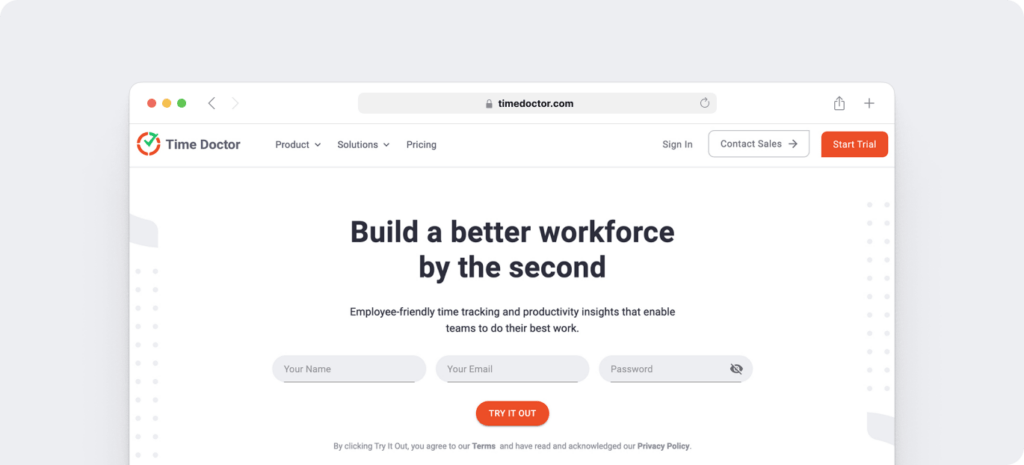Want to set up a hybrid office?
The pandemic has resulted in drastic changes in how and where we work.
While the office workplace keeps evolving continuously, this sudden need for evolution in the post-COVID world can be challenging for many companies. Various companies are now adopting either a remote or hybrid work model.
So how do you modify your workspace without reducing employee productivity?
In this article, we’ll take a deep dive into what makes a hybrid office, and explore the functions, benefits, and challenges of this work model. We’ll also share seven tips to successfully manage a hybrid office.
This article contains:
(Click on the link to jump to the desired section)
- What is a Hybrid Office Model?
- 4 Key Benefits of Incorporating a Hybrid Office
- 5 Challenges You Might Face While Managing a Hybrid Office
- 7 Practical Tips to Successfully Manage a Hybrid Office
Let’s get started.
What is a hybrid office model?
A hybrid office is a combination of remote and in-office working arrangements.
In this hybrid workspace, some employees are required to work from the office, while others can choose to work from home (WFH).
An organization may have certain types of roles that must be present at the workplace full-time. For example, knowledge workers like quality analysts for a food product need to work from the company laboratory.
Companies may also have departments (sales, marketing, etc.) that need not come to the actual office. They can then opt for a hybrid model, where some employees work in the office and some work remotely.
The flexibility and freedom offered by hybrid offices have enabled many companies and employees to function successfully even in the post-pandemic world.
It has also allowed them to follow social distancing norms by having distributed teams.
That’s why many corporate giants like Facebook, Google, and Amazon have adopted a hybrid office model and are remarkably successful.
Here’s some more information about hybrid companies.
4 key benefits of incorporating a hybrid office
There are a lot of advantages to incorporating a hybrid office. Let’s take a look at a few key ones:
1. Increased productivity
Employees who prefer to have a more flexible work schedule may put in more effort during their workday.
Despite initial apprehensions, surveys by CoSo Cloud reveal that around 77% of the remote employees have tracked increased productivity and higher performance.
The increase in productivity and the ability to focus on the task at hand may be due to fewer interruptions and distractions from colleagues.
Additionally, some remote employees are more productive and have a better work-life balance as they don’t have to worry about commuting to work regularly.
2. Happier employees
With the reduced stress levels in a flexible workspace, distributed teams tend to be happier and more motivated in their work. This encourages them to do more for the company.
Improving employee experience has additional benefits like higher retention rates, enhanced creativity and productivity, a positive office environment, etc.
All these factors can significantly propel your business forward – even in a lockdown situation.
3. Reduced costs
A hybrid workplace can reduce the operating costs of an organization in numerous ways:
- Reduced real estate costs due to smaller office space.
- Lower monthly bills for electricity, WiFi, etc.
- Fewer physical office supplies like snacks, stationery, cleaning supplies, etc.
As an employer, you can invest the money saved back into the business by creating marketing campaigns to build brand awareness and gaining more customers.
4. A Larger talent pool
In a hybrid workplace, the remote team can work from anywhere – home, a co-working space, or even a satellite office.
As an employer, this opens up various avenues for hiring remote workers.
You can select employees from a larger, global talent pool and hire them based solely on their skills and knowledge.
This helps to overcome any geographic boundaries that may restrict your hiring.
In fact, tech giants in San Francisco such as Google, Job.com, etc., are planning to incorporate a hybrid workplace model so that they can widen their reach to talented potential employees.

5 challenges you might face while managing a hybrid office
Let’s have a look at the most common challenges you might face while managing a hybrid company:
1. Team management
In a hybrid work environment, you can’t track office work or your remote team’s progress in real-time. As a result, you may not be on the same page as your employees.
Hybrid working may also prevent you from helping them if they need immediate advice or assistance.
Additionally, it may get even more challenging to manage the team if you have half the team working from an office space and the other half working remotely.
You may not be able to coordinate meetings, get a complete picture of the project’s progress, ensure uniform productivity from all team members, etc.
2. Communication issues
With distributed teams, you may not always be able to communicate with your entire team face-to-face whenever you want. It isn’t as easy as just walking into a conference room for a team meeting.
You need to consider the availability, schedule, and various other factors of the remote team before deciding the meeting time.
Ensure that you communicate any new policies, updates, projects, etc., with the remote and in-office teams simultaneously.
Additionally, internet or connectivity issues may hamper employee’s remote access to video meetings, various important data, etc.
3. Difficulty navigating new tools and software
Learning entire new systems, software, or tools can be a daunting task for many remote employees.
It can be challenging for those who have become accustomed to working a certain way. They may be reluctant to adopt new technology due to the fear of failure.
Without proper guidance, remote staff members can get lost, fall behind schedule, and even make critical mistakes.
4. Collaboration problems
Collaboration may be difficult to accomplish, especially when office workers aren’t comfortable with remote work.
Additionally, lack of proper communication, inability to use advanced software, and inadequate guidance can reduce the efficiency of hybrid team collaboration.
If teams aren’t able to conduct office work together, it might lead to:
- Missed team goals.
- Mistrust towards team members.
- Lowered overall employee productivity, etc.
All these factors are counter-productive for the team, as well as your hybrid company.
5. Limited team-building opportunities
Remote employees may miss out on team-building activities like team lunches, coffee shop breaks, company outings, etc., that happen in a traditional office.
Due to this, they may feel isolated and disconnected from their physical office peers, managers, and the entire hybrid workforce.
This can adversely affect their morale, productivity, and even the work environment.
7 practical tips to successfully manage a hybrid office
By utilizing the right techniques, tools, and software for your hybrid model, you’ll be able to fix the problems associated with remote work.
Let’s take a look at a few solutions:
1. Delegate tasks and projects
Modern technology has made it extremely easy to assign tasks and projects to various remote employees. This makes it convenient to keep track of the progress of individual tasks and projects and ensure their timely completion.
There are many excellent project management tools available today.
Selecting the right one will depend on your company’s needs and assigned budget. Some of the best project management tools include Trello, Asana, and Airtable.
2. Use advanced communication software
Clear and concise communication will always be vital in the success of any business, project, or task. And that’s why communication software is extremely popular today.
Now, there are tons of options – which can leave your head spinning.
Fortunately, we have narrowed it down to two categories:
A. Instant messaging
These apps are easy to use, making collaboration and communication simple for remote staff.
Some of these platforms include – Slack, Microsoft Teams, Chanty, etc.
B. Video conferencing
Remote employees may feel left out if they see that their on-premise team huddled together for a brainstorming session in the conference room.
High-quality video conferencing tools help bring uniformity in meetings through a remote meeting room.
The most popular choices include Zoom, Facetime, Skype, etc.
During video calls, you can ask all employees (remote and in-house) to log in from their own computers so that remote employees don’t feel isolated. It’ll also increase the camaraderie between the team members.
3. Improve team collaboration using intelligent software
Collaboration on certain tasks may be crucial and more difficult to maneuver from a remote position.
However, that won’t be the case if you have the right tools at your disposal.
Modern collaboration software enables teams to work seamlessly on common projects, irrespective of their physical location. You can use these tools to quickly share documents, chat with colleagues, etc.
Two of the popular collaboration tools include Google Docs and Microsoft Teams. Supplement this with cloud storage systems so that all your teams will always have access to important files and information no matter where they are.
4. Use Learning Management Systems (LMS) to train new employees
It can be challenging to learn about various new remote tools and the company’s work processes. An employee needs to master these tools and techniques quickly and use them to complete their tasks.
Offering good onboarding support and sufficient training to a hybrid worker can help them catch up with their colleagues quickly.
That’s where a Learning Management System (LMS) comes into the picture.
An LMS is software that provides documentation, tracking, reporting, etc., of educational courses, learning programs, and much more.
Here are some advantages of using an LMS:
- Reduces the learning and development time by streamlining and organizing the information in one place.
- Enables you to add new training modules to existing ones to provide continuous learning to remote workers.
- Tracks employee progress and performance using detailed analytics, which can help you modify the training session accordingly.
Some of the best Learning Management Systems include Fresh LMS, Blackboard, and Schoology.
5. Provide team-building opportunities
Team-building is essential for the success of any organization since it can help office workers resolve their conflicts, build trust, improve company culture, etc.
It’s even more critical in a hybrid team, where the workforce is distributed.
You can facilitate team-building in your hybrid team by:
- Hosting Zoom happy hour meetings.
- Enabling team members to meet (virtually) without managers.
- Using ice-breaking tools like Slack’s Donut to help members get to know each other better.
- Playing and enjoy virtual team games and activities together. Games like Clue Murder Mystery, Game Show Extravaganza and Code Break can be so much fun.
These techniques can go a long way in enhancing team bonding.
Here are more virtual team building ideas for your team.
6. Monitor your teams’ productivity
You need to ensure that any employee who works from home is actually working during office hours and not binge-watching shows.
So how do you monitor employee productivity?
There are various performance management tools like Time Doctor that can help your employees stay productive.
What’s Time Doctor?

Time Doctor is a performance management and time tracking tool proven to boost productivity for managers and employees. Large companies as well as smaller businesses such as Thrive Market use Time Doctor to monitor performance with ease.
Here’s a quick look at some of its key features:
- Manual and automatic time tracking to see time spent working on tasks.
- Tasks and projects that can be assigned to any specific employee.
- Productivity ratings for different websites and applications.
- Powerful, detailed reports to monitor hybrid team performance.
- Work schedules and attendance reports to track hybrid team attendance.
- Easy integration with leading project management tools such as Trello, Jira, etc.
- Send direct payment to an employee based on their working hours with Paypal and Wise integrations.
7. Consider employee prioritization
Employees are one of the most important assets of any company. Irrespective of the team size, all employees have essential roles to play in the success of your business.
That’s why focusing on their needs, expectations, and well-being can significantly increase workplace engagement and satisfaction.
Here’s how you can create an employee-first work culture:
- Help your remote employees understand your company culture so that they can better associate with it.
- Ensure that they’re accountable for their tasks so that they can be more responsible for their work.
- Acknowledge their successes and also their value to your company.
- Provide career development opportunities for all employees.
These steps can help remote workers feel connected to your hybrid company, even if they aren’t physically present in the office space.
Final thoughts
Remote working is certainly the future of work – whether it’s an entirely remote or a hybrid approach.
Carefully implementing the new procedures, selecting the right tools, and prioritizing your employees’ well-being is key to making your hybrid model thrive.
You can easily grow business even amid a pandemic, by utilizing the above strategies to adopt a hybrid workplace model.
Good luck!

Liam Martin is a co-founder of Time Doctor which is software to improve productivity and help keep track and know what your team is working on, even when working from home.


